Have you ever wondered how rare your eye color is? While brown eyes are the most common across the world, some colors are much harder to come by. Let’s explore the rarest eye colors, especially within the U.S., and what makes them unique.
What Are the Rarest Eye Colors?
Eye color is primarily determined by genetics, and the amount of melanin in your iris plays a significant role in the shade your eyes take on. The less melanin, the lighter the eyes. Here’s a breakdown of the percentage of the U.S. population with each eye color:
| Eye Color | Percentage of population with this eye color |
|---|---|
| Brown | 45% |
| Blue | 27% |
| Hazel | 18% |
| Green | 9% |
Is Green the Most Rare Eye Color?
Yes, green eyes are considered the rarest eye color in the U.S., with about 9% of the population having them. Globally, only about 2% of people have green eyes, making them very uncommon worldwide.
However, even more rare are unusual shades like amber or gray, and conditions like heterochromia, where a person has two different colored eyes. These colors are so rare that they account for less than 1% of the population in the U.S. and globally.
Exploring Rare Eye Colors: Beyond Green Eyes
Amber Eyes: Amber eyes are characterized by a golden or coppery hue. They result from higher amounts of lipochrome, a yellow pigment in the iris. Amber eyes are one of the rarest, making up a tiny portion of the population, both in the U.S. and worldwide.
Gray Eyes: Often mistaken for blue, gray eyes are their own distinct color. They have a silvery or smoky appearance and are found in only a small percentage of people, mostly in Eastern Europe. Gray eyes are even rarer than green and blue.
Heterochromia: Heterochromia refers to the condition where a person has two different colored eyes, such as one blue eye and one brown eye. This striking genetic trait is exceedingly rare, found in less than 1% of the population.
What Causes These Eye Colors?
The color of your eyes is determined by several genes, with the OCA2 gene playing the most significant role. This gene influences the amount of melanin, or pigment, in the iris. While we used to think that only one gene dictated eye color, modern research shows that multiple genes are involved, creating a spectrum of colors.
In very rare cases, medical conditions or injuries can alter eye color over time. Conditions like Horner’s syndrome or Fuchs’ heterochromic iridocyclitis may result in the lightening of the iris, but these occurrences are not common.
Eye Color and Vision
You might be wondering if rare eye colors affect vision. For the most part, the color of your eyes doesn’t directly impact how well you see. However, people with lighter-colored eyes, like blue or green, are more sensitive to light because they have less melanin to protect against harsh sunlight. Wearing sunglasses with UV protection can help reduce discomfort if you’re sensitive to bright light.

If you’re curious about protecting your eyes, check out our resources on eye health at Heartland Optical.
Eye color is one of the many fascinating traits that makes each of us unique. Whether you have common brown eyes or a rare shade like green, gray, or amber, your eyes are a reflection of your genetics. While rare eye colors can make for interesting conversation, keeping your eyes healthy should always be a priority.
If you notice any changes in your vision or eye color, it’s essential to see an eye care professional. For tips on eye health or any eye-related questions, explore our other helpful resources at Heartland Optical.























